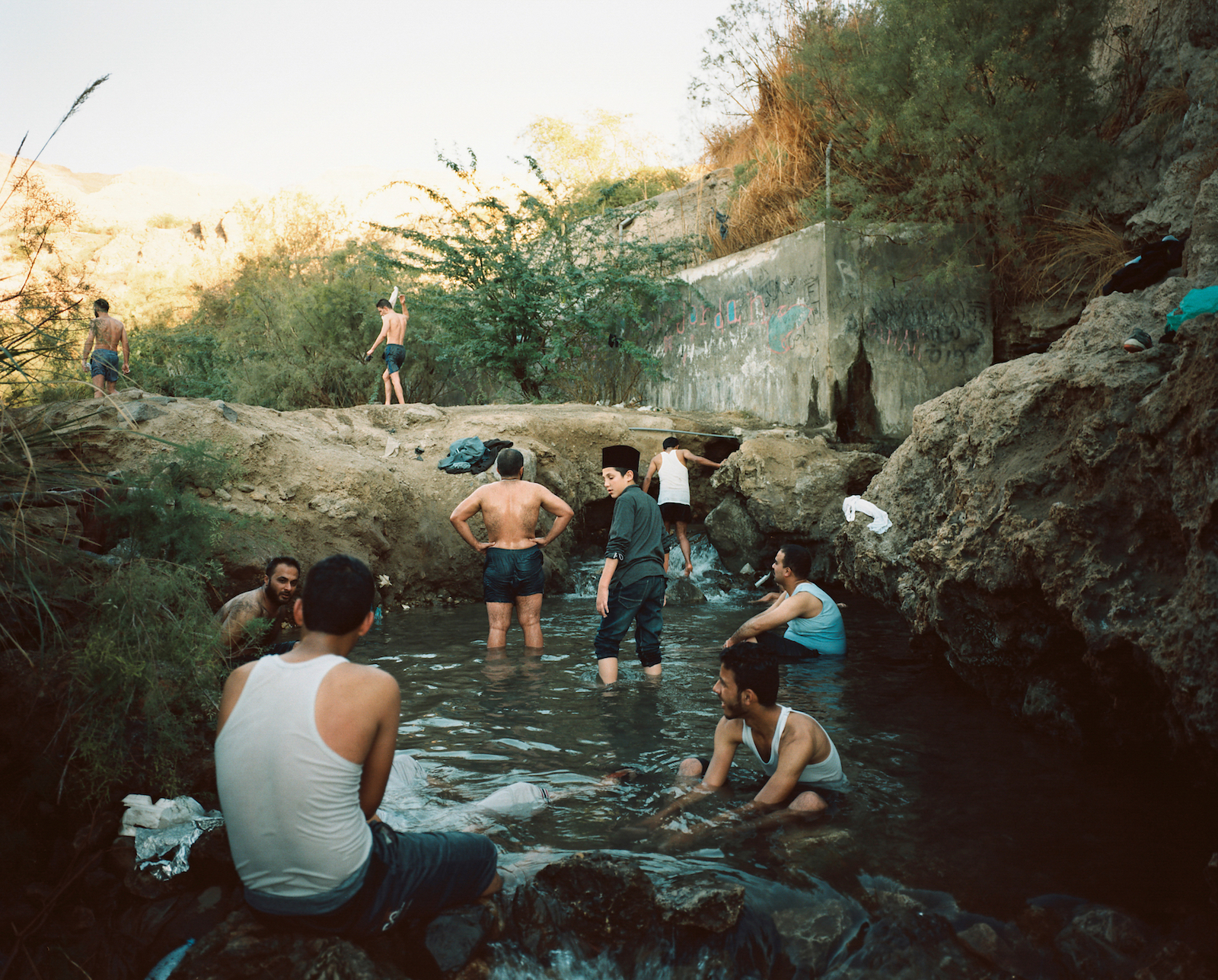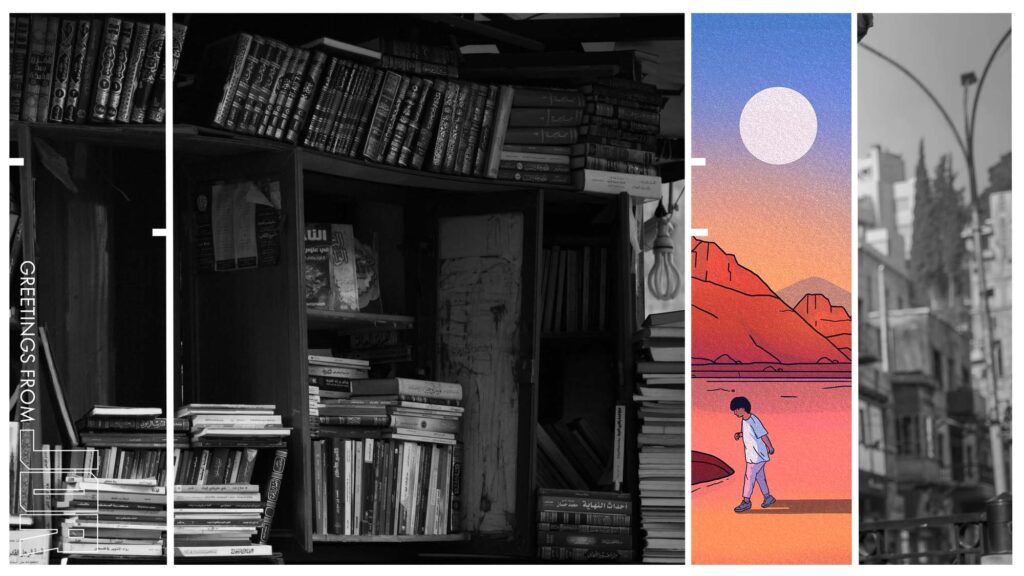A large number of Storythings projects are global. So when we commissioned these stories, we wanted voices from around the world. To write a response to Hisham Bustani’s story about future culture in the MENA region, we were lucky to be connected with Rana Sweis, who is not only a Jordanian journalist but runs her own media company. We asked Rana to give us a reading list that would give readers more insight into Jordan where ‘Three in One’ is set.
Similar to Rana’s list, we curate creative stories from around the world in our weekly newsletter; and in the past we published a lot of stories from the Global South in How We Get To Next, for the Gates Foundation. If you’d like to commission creative stories to better communicate an issue important to you, do reach out – we’ve recently worked with Experian, Nesta, Young Epilepsy, Turner Contemporary and Northern Stage to help them do just this.
1. ‘Desert Sorrows’, poems on love and politics by Tayseers Al-Sboul (2015).
Tayseer Al-Sboul is one of the most prominent Jordanian writers and poets. It is said that his friends established the Jordanian Writers Society after his death, inspired by Sboul’s writings. He embodies the journey of Jordan as a country and society; both in his life, his family’s background and his writings. Unfortunately, Sboul suffered from severe depression and eventually committed suicide. ‘Desert Sorrows’ translated by Nesreen Akhtarkhavari brings his life and his writing to a Western audience. Hisham’s story mentions the Jordanian Writers Union and how the narrator was once heading it. He also mentions that he can see the association from his window.
2. Fadia Faqir, ‘Willow Trees Don’t Weep’
Fadia Faqir is an author, academic and defender of human rights. She speaks in this short video about the inspiration behind her novel, ‘Willow Trees Don’t Weep’. Although Faqir lives in the UK, she speaks and writes extensively about the Middle East, and Jordan as well. Her novel tells the story of a young Jordanian who goes on a journey to find out about her father who left home a long time ago to join the Jihad in Afghanistan. What struck me about the premises of Faqir’s novel in relation to Hisham’s short story, is the rebelling of the father against the notion of community, the patriarch and the family man in Jordan. Instead, he went to fight for another cause, abandoning his family and country.
3. Rula Quawas on women in Jordan
Quawas was an inspiration to many of her students at the University of Jordan. In addition to being an academic, she was a champion of women’s advancement in the country. She was removed as dean over a video project in which her female students exposed the sexual harassment they endured on campus. She died aged 57 on July 25th 2017 in Amman, Jordan. Instead of sharing an obituary or her writings, I wanted to share her voice. Rula left this world too soon. She too, like the narrator in ‘Three in One’, left no children of her own behind. Perhaps the narrator does not realize the impact of his writing on his readers, even his daily encounters, and the legacy he will leave behind. He seems unaware.
I wanted to go beyond the daily life in Amman described in ‘Three in One’ to give the reader a glimpse into both life in the wider country and the larger challenges that Jordan is facing.
4. Nadia Bseiso, Infertile Crescent
‘The next war is a water war’, Bseiso writes. Her project, Infertile Crescent, is a collection of beautiful photographs that depict the interaction between nature and people in Jordan today. In my opinion, her photographs reveal the dwindling of natural resources, preservation and the impact of climate change on Jordan. I wanted to go beyond the daily life in Amman described in ‘Three in One’ to give the reader a glimpse into both life in the wider country and the larger challenges that Jordan is facing.

5. Coldplay in Jordan
On November 22nd 2019, Coldplay chose to launch their album ‘Everyday Life’ in Jordan. I watched it live on YouTube and I just loved the concept because the first half of the album was performed at sunrise and the second half at sunset. The setting made me think of Hisham’s story. From where Coldplay performed you can look at all of Amman. I remember it was really cold that morning but they braved it and it was really special. The sunrise images in the live performance reminded me of Hisham’s description of an image the narrator had on Wednesday 29th May 2024. The site of the performance is also not too far from Darat al Funun and Artist Syndicate, referenced in ‘Three in One’.
6. Moises Saman: Photograph under curfew (paywall)
I have been a big fan of Saman’s photography ever since the Second Gulf War and his coverage of the Israel-Palestine conflict. I think this photo and text are powerful when we look back at the impact of a total lockdown and curfew at the beginning of the coronavirus outbreak. Hisham’s story is very much set during this lockdown and curfew in Jordan, and mentions the lockdown’s devastating consequences on its citizens.
7. Amman Journal: Finding Refuge in Jordan, and Adding to Its Cultural Mix (paywall)
This is an article I worked on with my colleague, Somini Sengupta for the New York Times that celebrates diversity. Jordan has absorbed successive waves of refugees fleeing war and chaos. We hear mostly about the negative impact of refugees and unwanted changes in a country like Jordan, with its limited resources. But in fact this article highlights how much they add to the cultural mix. Hisham’s story highlights the ‘nominal refugees’ from the Israel-Palestine conflict. In addition, I wanted to give more context by highlighting the successive waves of refugees to Jordan from other countries, most recently from Syria.
8. An unloved museum
One of my favourite museums in Jordan is the Jordan Archaeological Museum in Amman. But you can’t help but feel how neglected it is. My friend and I call it the ‘unloved museum’. It has so many treasures that would be cherished in other countries, but seem to find no love here. The media website, Al Bawaba, reports that ‘Lack of space prohibits the display of temporary exhibitions; however, the museum participates in many local and international exhibitions held in Jordan and abroad to show the history and archaeology of Jordan throughout the ages. Three curators share the responsibility of looking after the whole collection of the museum.’ Hisham mentions several museums, including the Museum of Jordan, and cultural institutions that were forgotten during the pandemic and lockdown. So I felt this ‘unloved museum’ was worth mentioning.
Here are photos from the museum and an amateur video tour of it, as well.
9. Issam Alnajjar, ‘Hadal Ahbek’
‘Hadal Ahbek’ is a catchy tune by a Jordanian teenager who was just featured in Forbes ’30 under 30′. He has 1.5M followers on TikTok and his song was watched 87 million times on YouTube in less than a year. The scenes in the music video are shot in Jordan and the lyrics are translated into English. The theme of young love will resonate worldwide. It also shows the promise of Jordan’s youth, who make up the majority of the population, but at least half are unemployed, according to statistics. Having such a high unemployment rate, and thus severe financial struggles, which Hisham speaks extensively about in ‘Three in One’, robs people of many opportunities and dignity. Also, Hisham mentions the narrator’s loss of status as a writer in comparison to ‘social media influencers’, perhaps a reference to the younger generation.
10. Jordan: From Dreams to Reality
Jordan: From Dreams to Reality is the title of a virtual art gallery that will launch on October 31st and remain on display until the end of the year. It features the artwork of Jordanian artists from different backgrounds using various mediums to express their take on political, social and cultural issues and challenges in Jordan. Each artwork features an explanation and information about the artist. The artworks include themes that Hisham mentions in his story, such as freedom of expression, the Arab leader, the Arab Spring, the lockdown in Jordan and more.
(The exhibition hasn’t launched yet, but it will appear here when it does)
Rana Sweis is a Jordanian journalist covering political, social and refugee issues in the Middle East, most often for the New York Times. She is the author of Voices of Jordan (Hurst Co.), a nonfiction book about modern-day life in Jordan. She is also the founder and managing director of Wishbox Media, a provider of media training, research services and digital storytelling packages. She holds an MA from George Washington University’s Graduate School of Political Management.
